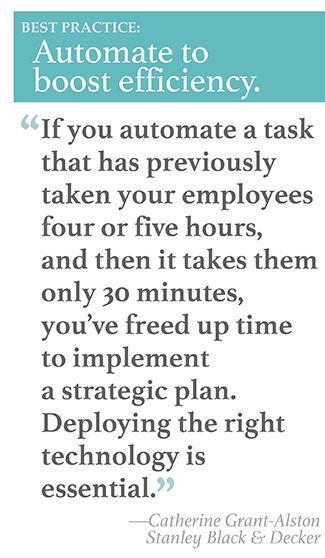
When the management team at Stanley Black & Decker rolled out their strategic goal of growing the global business from US$13 billion to $22 billion in annual revenues by 2022, mergers and acquisitions (M&A) became a key pillar of the corporate strategy. The increased M&A activity has been successful in growing the business, but it has come with a side effect: an increasingly diverse technology and banking infrastructure.
“A few years ago, we had over 100 ERP [enterprise resource planning] systems and more than 2,000 bank accounts with approximately 200 different banks,” explains Catherine Grant-Alston, director of global cash operations for Stanley Black & Decker. And the treasury team's processes for managing liquidity across this web of accounts and accounting systems was inefficient, at best.
For example, the company's treasury management system captured liquidity information only for U.S.-based business units. “We were a global company that could only see our U.S. liquidity profile, which was a small portion of the overall company's portfolio,” Grant-Alston says. “Our general ledger [G/L] entries were manual. We would work with our finance teams around the globe to get ledger balances at month-end, but the other 29 days of the month were piecemeal. We would send emails to newly acquired entities that were not yet integrated, asking, 'What was your bank account balance as of Friday? And what does your forecast look like for the next two weeks?' It was the perfect storm of a global company using antiquated processes.”
To modernize finance processes, Stanley Black & Decker launched a single instance of SAP to serve as a centralized global ERP system and began moving business units onto the platform. The treasury team, meanwhile, saw the opportunity to streamline their own processes. “We wanted to be able to easily and automatically see global liquidity,” Grant-Alston says. “We also wanted to automate payments globally. It was daunting because every bank needed its own connection. Even within a single global bank, every country needed its own account-mapping exercise to make sure we were capturing all the necessary fields.”
After researching treasury solutions, Grant-Alston pitched the corporate treasurer and assistant treasurer on the benefits of using technology to streamline payments and cash management. When she got treasury leadership on board, she worked with corporate IT to develop a business case.
“The first thing I did was look at how much we were spending on duplicate charges,” she explains. “Whenever a bank statement needed to be reported to both treasury and an ERP system, we would be hit with duplicate charges. We looked at the cost of setting up each host-to-host solution between our various internal systems and our core banks. We gathered information on file transmissions and how much we were being charged for people to be in the banking systems pulling reports. We saw that pulling this information into a single centralized system could eliminate most of these costs and generate a 30 percent ROI [return on investment].”
 The project team also evaluated the risks of fraud and of putting all treasury's eggs in a single technology basket. “If we are sending out millions and millions of dollars a day, a system outage becomes catastrophic,” Grant-Alston points out. “We had to understand how to make the system as secure and reliable as possible.”
The project team also evaluated the risks of fraud and of putting all treasury's eggs in a single technology basket. “If we are sending out millions and millions of dollars a day, a system outage becomes catastrophic,” Grant-Alston points out. “We had to understand how to make the system as secure and reliable as possible.”
On the flip side, the team saw that centralizing payments and global liquidity management would improve controls around the world, streamline compliance activities anytime regulatory requirements changed, and facilitate faster and easier on-boarding of new businesses after a corporate merger or acquisition. The treasury and IT staff added a risk assessment to their ROI calculations, then jointly pitched the project to senior management.
As a result, Stanley Black & Decker deployed FIS's Quantum software-as-a-service (SaaS) treasury management system and Trax payment processing software. The combined solution automatically receives daily feeds of BAI and MT940 files through the SWIFT network for the majority of Stanley Black & Decker's operating bank accounts around the world.
“We started with receiving prior-day bank balances,” Grant-Alston explains. “But in regions where we tend to have a lot of cash on the table, we started to get intraday statements.” Quantum feeds the bank information into appropriate internal ERP systems for automated G/L entries and account reconciliations.
This process upgrade has led to substantial cost savings. “We get the reporting in one feed, so we can stop paying for so many different connections,” Grant-Alston says. More important, the solution gives treasury a much clearer view into global liquidity than the prior workflow of one-off emails could provide. “We can see our global cash structure, and we can consolidate our cash appropriately. When we need to fund strategic initiatives, we can see the holistic picture of how to do that.”
The company centralized and automated debt payments and treasury payments within Quantum. It also centralized accounts payable (A/P) payments in Trax, enabling automated payment reconciliations and controls. The software can receive information in any of 90 different file templates, then generate ISO 20022 payment files for transmission to banks in the many geographic regions where Stanley Black & Decker operates. “In the future, when acquisitions are still using their own systems, we can just have them provide a CSV [comma-separated value] file or a flat file, and Trax will convert it to the right format,” Grant-Alston says. “That means we can immediately bring them into the system that has automated connectivity to the bank.”
See also:
- Webcast: Successful Treasury Transformation and Innovation through Technology Excellence
- Extending Visibility and Productivity for Extended Payment Terms
- APIs Automate Booking of Payments that Defy Standardization
In addition, Stanley Black & Decker is utilizing Quantum to monitor long-term debt in the system, automate accruals, journal entries, and cash accounting for Stanley Black & Decker's corporate entity. “Whatever happens in the bank account, we automatically generate the necessary account coding for those transactions,” Grant-Alston says.
Maintaining all this information in the treasury system gives executives greater visibility into corporate cash. “We send a daily report to management that shows our long-term and short-term debt as well as a snapshot of the 80 to 90 percent of our global liquidity that is centralized,” Grant-Alston says. “When the CEO, CFO, and treasurer are looking at strategic initiatives and M&A opportunities, this information is critical.”
The initiative has been a tremendous success, introducing both visibility and efficiencies to cash management processes at Stanley Black & Decker. Grant-Alston sees these types of automation as crucial for every modern treasury department. “The times have changed,” she says. “Technology is an enabler, and if you do not automate, you will get left behind.
“If you automate a task that has previously taken your employees four or five hours, and then it takes them only 30 minutes, you've freed up time to actually implement a strategic plan for your company to grow. You can't expect to continue to grow profitably without providing efficiency for your tasks. Deploying the right technology is essential,” she concludes.
© Touchpoint Markets, All Rights Reserved. Request academic re-use from www.copyright.com. All other uses, submit a request to [email protected]. For more inforrmation visit Asset & Logo Licensing.



